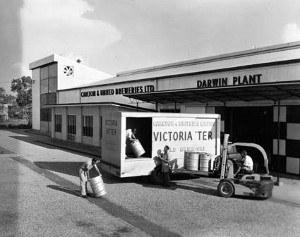
Australia's post-war breweries
There is a myth at large that no new breweries were built in Australia between the Second World War and the appearance of the Sail and Anchor Pub Brewery in Fremantle in 1984.

CUB Brewery Darwin 1958
Take, for instance, a recent (November 2012) article in Perth’s Sunday Times Magazine, which calls the iconic Fremantle hotel ‘Australia’s first brewery to open since World War II’, and two earlier articles in the West Australian in 2004, admittedly of common authorship, which described it the same way.
It is a myth so easily debunked, however, that one is surprised that it came about. My re-reading of many articles written in the distant eighties about the then new and novel Sail and Anchor brewery suggest that the originators of the myth were not the various writers who spruiked it then. It is apparently of more recent derivation.
The purpose of this article is not, however, to search for the origin of the myth. Nor it is to reprimand journalists who have carelessly fallen into the trap of assuming that something about which they had no knowledge had never existed. Instead, and more constructively, it is to answer the question: ‘If there were others, what and where were they?’
When the Sail and Anchor opened in 1984, the now-recently-closed Swan Brewery in the Perth suburb of Canning Vale was still very new. It had been formally opened in March 1979, less than six years before. Perhaps it didn’t count in the minds of the myth-makers, as it was only a replacement for its owner’s two existing breweries, the Swan and the Emu, in inner Perth.
Both Swan Brewery Co. Limited of Western Australia and Carlton and United Breweries Limited of Victoria built new breweries in the Northern Territory after the Second World War. Of the two, CUB was first, brewing the first beer at its new brewery at Berrimah in October 1957. Swan followed soon after, commencing production at its superior Stuart Brewery at Parap in 1958. There was also the ill-fated Ellis-Kells Brewery, which operated briefly at Darwin in 1951.
In Queensland, Carlton and United Breweries Limited opened a new brewery at North Rockhampton in 1970. I am unaware of any new breweries being opened in South Australia after the war until several small ones appeared in Adelaide in the 1980s, all after the Sail and Anchor. A similar scenario applies in Tasmania.
Two new breweries were started in Victoria after the Second World War, the better known of which is undoubtedly the Courage Brewery at Broadmeadows, where beer production began in August 1968. The other new Victorian brewery was built by the Heley family, soft-drink makers at Mildura, in the mid-1960s. Brewing of low-alcohol beer began at their Mildura brewery about the same time that Courage started brewing at Broadmeadows. Full-strength beer was added to their product range in 1971.
The Australian state in which the most new breweries were created after the Second World War is New South Wales. Tooheys Limited completed a large modern brewery at Lidcome in 1978, but like the Swan Brewery at Canning Vale, it was to replace an ageing inner-city facility. The same company built a new brewery in the Newcastle suburb of Cardiff, where brewing began in August 1970. The Hunter Brewery, as it was known, was officially opened in February of the following year. Tooth and Co., the other half of the New South Wales brewing duopoly of the 1970s, built a brewery near Lismore, in the far north of the state. Beer from it first went on sale in September 1979.
In addition, three new breweries were started in New South Wales in the more immediate post-war years, beginning with one at Branxton in the Hunter Valley, where production commenced in December 1951. The Brookvale Brewery in the Sydney suburb of the same name soon followed, with production commencing in January 1952. Much more significant was a brewery created at Grafton, where beer production started in November 1952. The first Grafton-brewed beer was sold over the counter in Grafton pubs in the following month.
That makes thirteen new breweries opened across the country between the end of the Second World War in 1945 and the creation of the Sail and Anchor nearly forty years later. Not many, I grant you, especially compared to the vastly bigger number—about two hundred and sixty—that have started in the last nearly-thirty years since the Sail and Anchor, but certainly not none. They are a lesson to us to take care with the use of the F-word (first) in describing anything, and especially something about which we know little.



